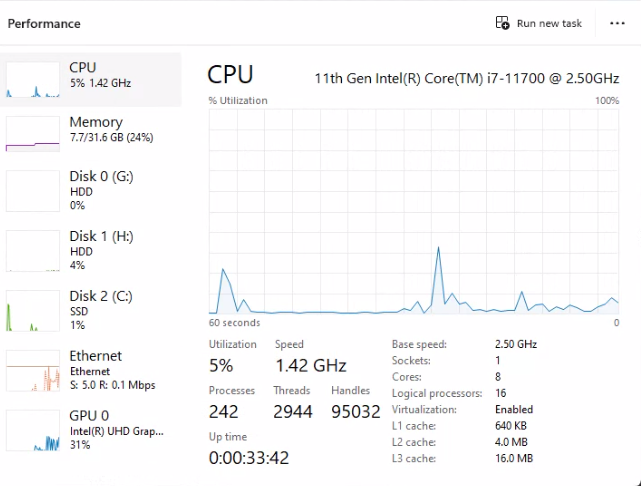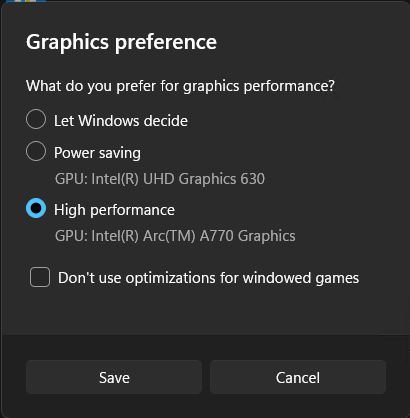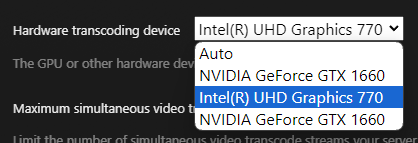Running PlexMediaServer-1.40.1.8122 on Intel NUC13ANHi3 with i3-1315U and UHD graphics. I guess that hardware tone mapping works in my system.
Just wanted to say thank you for finally supporting this on Intel / Windows. Tone mapping is working as expected transcoding to my firestick on my old plasma 1080p TV.

Is there a way to improve the picture quality when using ARC 770 hardware transcoding/tone-mapping?
There are at least two issues. It’s obviously very dark, but it’s also quite blocky, especially during movement. You can see it if you look close at his face.
ARC 770:
Software:
The only way I can get it to use hardware tone-mapping is to restrict the GPU in Settings:

Server: Windows 11
Client: Edge
I would like to help with that too. But I only have a little time at the moment. How can I test this quickly or with little effort on my system? Can someone give me a link or briefly explain it to me?
10th Gen (Ice Lake) CPUs not supported. Only 11th Gen (Tiger Lake) and later.
See first post in thread.
Ok, I obviously misunderstood. Thanks for the clear pointer. I just skimmed over it. As I said, not much time at the moment.
Then I’ll probably have to wait for the OpenCL implementation. I was able to test it successfully with Jellfin.
What are your experiences with the subtitles here? This was also not possible in Linux in the past. @savetheplatypi @LakeSurfer
I cannot test this preview either. My systems are too old.
My Plex server is an i5-10500T running Ubuntu. Subtitles work fine, as long as Plex does not have to burn them into 4K media. Burning into 1080p & lower resolutions is not a problem. Subtitle burning uses the CPU. Mine is not fast enough to burn subs into 4K video. I’m not sure CPU would be able to do so.
Yes, you’re right, 1080p is not the problem, but I thought we were basically only talking about 4K here, since the 1080p HDR (10bit) content is very manageable or hardly exists. But yes, an important feature for 1080p content too.
I updated the links to address some device selection bugs which would result in transcoder errors similar to Device creation failed: -1313558101.
Intel N100
Windows 11 v23H2
Onboard graphics with most recent intel driver
Testing with the new build (8190) I am still reproducing the same issue the previous builds had. AV1 tonemaps in hardware. HEVC is still falling back to software.
I’m seeing these errors in the console when trying to play HEVC from the Android Client.
[Req#547/Transcode/c5fa68fc2c9f8e5d-com-plexapp-android/64cf3f60-777f-492d-9015-5fe0817f54e2] [Parsed_vpp_qsv_1 @ 000001915d6a4380] Error running VPP: unknown error (-1)
[Req#569/Transcode/c5fa68fc2c9f8e5d-com-plexapp-android/64cf3f60-777f-492d-9015-5fe0817f54e2] Error while filtering: Unknown error occurred
[Req#56c/Transcode/c5fa68fc2c9f8e5d-com-plexapp-android/64cf3f60-777f-492d-9015-5fe0817f54e2] Failed to inject frame into filter network: Unknown error occurred
[Req#56f/Transcode/c5fa68fc2c9f8e5d-com-plexapp-android/64cf3f60-777f-492d-9015-5fe0817f54e2] Error while processing the decoded data for stream #0:0
I’m seeing these errors in the console when trying to play HEVC from the Chrome desktop browser.
[Req#1537/Transcode/maxei3a6maebndvwh82fevbi/0b62a687-b6b4-4f4e-b0c9-d43e6da47d44] [Parsed_vpp_qsv_1 @ 00000231b3166e00] Error running VPP: unknown error (-1)
[Req#1558/Transcode/maxei3a6maebndvwh82fevbi/0b62a687-b6b4-4f4e-b0c9-d43e6da47d44] Error while filtering: Unknown error occurred
[Req#155b/Transcode/maxei3a6maebndvwh82fevbi/0b62a687-b6b4-4f4e-b0c9-d43e6da47d44] Failed to inject frame into filter network: Unknown error occurred
[Req#155e/Transcode/maxei3a6maebndvwh82fevbi/0b62a687-b6b4-4f4e-b0c9-d43e6da47d44] Error while processing the decoded data for stream #0:0
This version (8190) now works for me on my 12500. I tried some h265 4K HDR files, and it resulted in about 30% CPU and 100% Intel iGPU usage, about what I’d expect for hardware transcoding together with tonemapping.
Error running VPP: unknown error (-1) is very unhelpful, thanks intel… @mordenk I will see what i can do but that error is not a lot to go on. are you able to successfully transcode without tonemapping?
In this build the only video content I’m seeing hardware transcode is AV1 files. HEVC and H264 are staying software only.
Correction. With this build (8190) qsv only seems to work if i have a running RDP connection to the server. As soon as I exit the RDP session, and start playing the same file, it goes back to software transcoding. I tried this a few times, and it’s reproducable. Am I reading this right, is it trying to use the nvidia card with qsv when rdp is closed?
no_rdp.txt (170.5 KB)
with_rdp.txt (135.8 KB)
We’ve seen that type of issue before. Until a fix arrived, the workaround was to run PMS as a proper Windows service.
(Which is recommended anyway, if your Plex server machine is running headless.)
@tonigreywater can you try something for me? can you try starting PMS with no RDP session and look at the list of GPUs and then stop PMS, start RDP, start PMS, and take another look. Is it the same list?
You’re onto something…
no rdp:

with rdp:

I used SSH to restart Plex, as it sadly doesn’t have a way in the web ui to do so. To be clear, the system only has one GTX 1660 installed.
edit: added second image
P.S.: I can also confirm @jibbers42 findings. With QSV tone mapping, the image appears noticeably darker than with software or nvenc tonemapping.
Intel N100
Windows 11 v23H2
Onboard graphics with most recent intel driver
@chris_decker08 I agree I think you’re on to something. I retested after starting plex over RDP instead of using RealVNC like normal. This appears to fix the issue for me. H264, HEVC and AV1 all transcode in hardware, including tonemapping on HEVC and AV1, as long as I start PMS during an RDP session.
I also see a duplicate gpu in the transcode list when using RDP like @tonigreywater
PMS looks for GPUS at startup time, and it appears that windows is shuffling around GPU indexes in an odd way when remote connections are started and/or ended. I will look into a way to dynamically re-load GPUs when they change, but in the meantime i would suggest you two look into using PMS as a Service
Here is a user report and HowTo about the issues of running video hardware transcoding in the context of a RDP session: Windows Remote Desktop breaks HW Transcoding (QSV) - Here's the fix!




